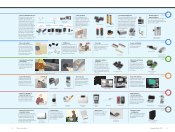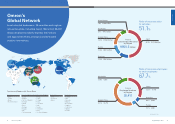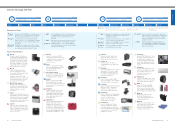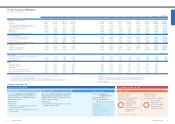Omron 2013 Annual Report Download - page 18
Download and view the complete annual report
Please find page 18 of the 2013 Omron annual report below. You can navigate through the pages in the report by either clicking on the pages listed below, or by using the keyword search tool below to find specific information within the annual report.
32 Omron Corporation Integrated Report 2013 33
Where We're Headed
Collaboration between Industry,
Government, and Academia
to Invigorate Local Societies
As one way of rooting our operations to the regions
in which we work, we are placing an emphasis on
education, not only of our employees but also of the
students that will support the future of these regions.
Omron is working to share its corporate philoso-
phy with educators in Asia while also providing
opportunities for students to learn about environ-
mental issues and the latest technologies. At Chi-
nese vocational and technical colleges*, we help
teach students about manufacturing while they are
in school and hold Omron Classes, which attract vast
quality human resources. In addition, we hold the
Omron Cup Sterling Engine CAR Contest and design
contests, which are based on the themes of environ-
mental preservation and recycled resources. We also
hold the National University Student Photoelectric
hours a day doing nothing but confi rming variables.
By introducing computers equipped with data log-
ging software along with controllers, IAB helped
create a system in which all this numeric data is
recorded automatically by computers. This system
successfully reduced the amount of time employ-
ees devoted to these monitoring tasks to one hour a
day. Workers were thus freed from the task of con-
fi rming variables all day long, which in turn allowed
them to use this time to revise production process-
es and implement other improvement activities.
3. Automation Example (Thailand)
Electricity-Saving Initiatives
Rising costs in Thailand have resulted in a shift
toward less-wasteful activities at production sites.
Effi cient electricity use is being considered as one
way of realizing such activities. As such, factories
are increasingly introducing electricity monitoring
equipment, which can be used to track how much
electricity is being used in specifi c parts of a facility.
In order to respond to such global issues related to
safety and the environment as well as the need for
high-speed, high-precision control, IAB accumulates
cutting-edge technical expertise within its Automation
Centers* so that it may transmit unique technologi-
cal applications throughout the world.
* Automation Centers provide support services to help people make machines move
as they please. The support services provided by these centers include easing the
connection of equipment from different manufacturers, a task that previously
required substantial time investments, and assistance in realizing high-speed,
high-precision control for demanding pieces of machinery. Also, the centers help
customers quickly install machinery with ease. In these ways, the centers aid our
customers in developing competitive machinery setups.
Evolution Driven by Customer Needs
We work to address the various issues faced by
specifi c regions by developing solutions from the
perspective of local customers in these regions.
The number of products with different specifi ca-
tions produced by OMS has grown 2.5 times over
the past three years. When looking at the average
employee turnover rate in China, OMS has em-
ployee retention rates that are 3 to 5 times better
than the average. Nonetheless, its operations are
impacted by the rising labor costs and labor short-
falls in coastal areas. For this reason, OMS is em-
ploying Low Cost Intelligent Automation (LCIA) to
make its production operations in this country more
fl exible. Such fl exible production operations are
supported by small robots, a culmination of our
accumulated knowledge and expertise, and the
skills of employees are used to backup this system
while eliminating wastes.
Also, OMS is currently holding tours of its
factories for a wide range of visitors. We hope
that these tours will provide customers with a
model example to be considered in solving their
automation issues while at the same time offering
an opportunity for local companies to learn from
our production expertise.
Source: Japan External Trade Organization (JETRO)
Note: Personnel expenses include basic salary, allowances, social security, overtime
payments, and bonuses.
Yearly Personnel Expenses
in Asia’s Manufacturing Sector
0
2,000
4,000
6,000
8,000
China Thailand Malaysia India Indonesia Vietnam Bangladesh MyanmarThe
Philippines
Fiscal 2009 Fiscal 2012
(US$)
Design Contest to help foster the development of
prospective automation engineers and provide edu-
cation regarding state-of-the-art technologies.
* Equivalent to technical colleges in Japan
Optimal Relationship between People
and Machines
Out of our development bases in Japan, Europe,
and the United States, we are able to develop an
understanding of the latest trends related to tech-
nologies and international standards. By leveraging
this advantage of our global operations, we hold
seminars and otherwise provide information to help
spread knowledge.
We also participate in committees for developing
safety standards. In such ways, we are working to
develop social foundations that enable a safe and
optimal relationship to be developed between
people and machines.
Pursuit of Further Evolution
The future of market conditions remains unclear.
Nevertheless, we will continue to take on new
challenges to create innovation while advancing
steady improvements through straightforward and
earnest effort. To this end, we are rethinking the
parts we use, reducing the number of parts con-
tained in our products, revising production pro-
cesses, and otherwise refi ning our technologies.
As automation spreads, people’s lives become
more fulfi lling, which in turn enables them to be more
creative at work, leading to the further evolution of
automation. Looking back at the history of automa-
tion, it is clear that demand for automation will con-
tinue growing into the future, as will its potential.
IAB will create cycles in which changes in soci-
ety’s needs and technical innovation give birth to
one another. And these cycles will be created
around the world. IAB will also work to grow as the
provider that is “No. 1 in control,” “No. 1 in product
lineup,” and “No. 1 in the future” so that it can
make greater contributions to the ever changing
Asian market.
We automate!
Soldering by hand
LCIA soldering robots
• Stable levels of quality
• Capital investment 1/3–1/4
























